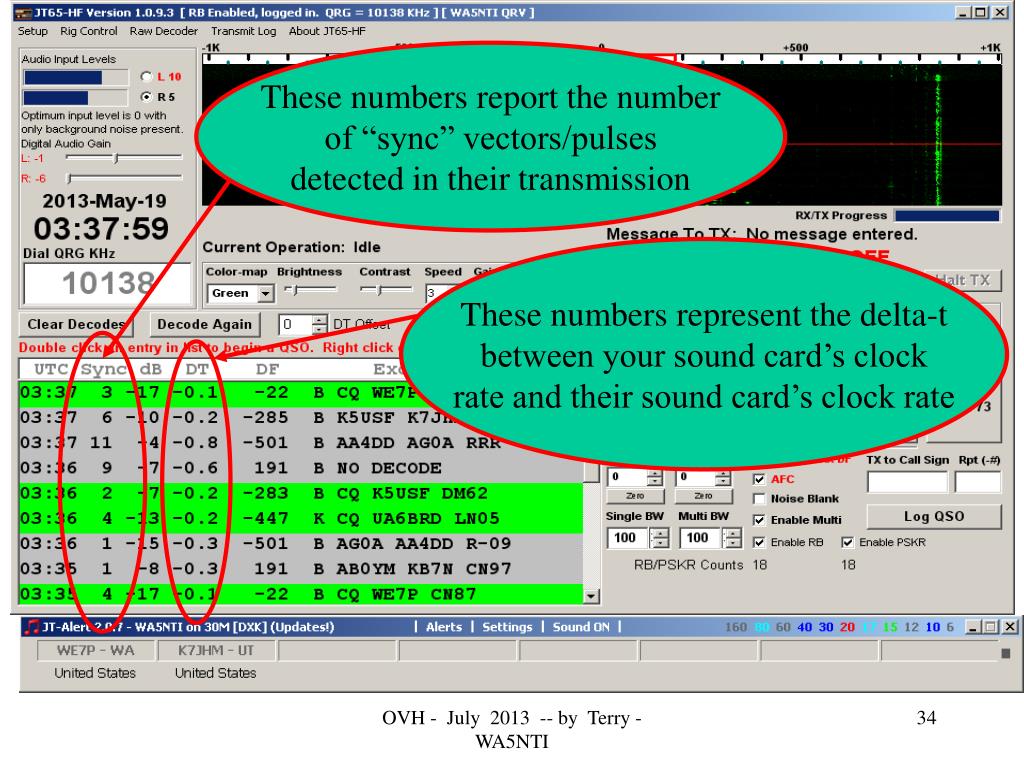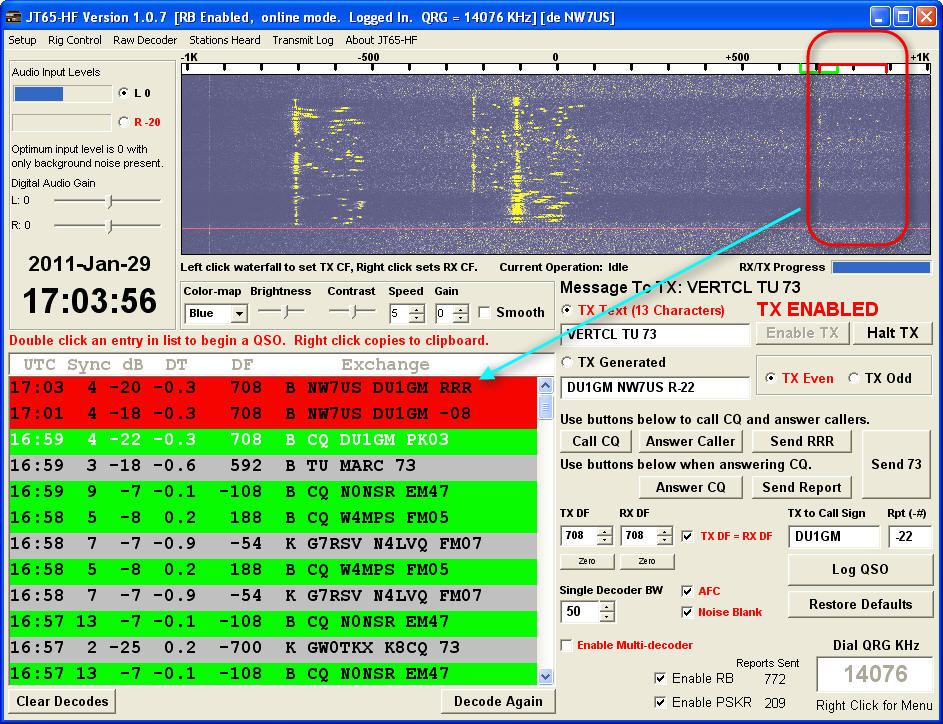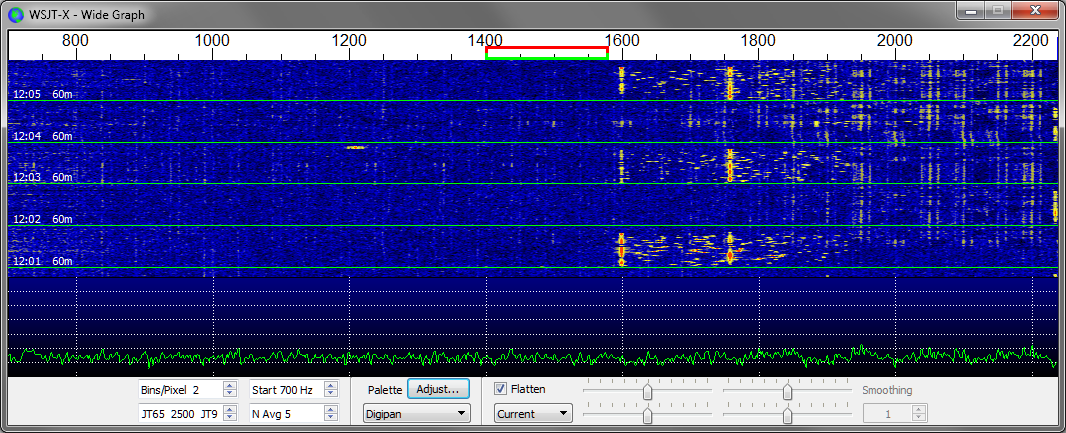

Synchronization uses 7x7 Costas arrays at the beginning, middle, and end of each transmission.
#JT65 SOUND CODE#
“Forward error correction (FEC) in FT8 uses a low-density parity check (LDPC) code with 75 information bits, aġ2-bit cyclic redundancy check (CRC), and 87 parity bits making a 174-bit codeword. Under the hood, there’s some complex mathematics going on. The cost of turning us into passive observers as our computers make QSOs for us. Automating the normal sequence of standard messages reduces the thinking time issue, at

The sensitivity is still remarkable, hence a few watts are generally adequate if a path is Very little thinking time about what message to send next in response to the message received andĭecoded. The downside of the extra speed (compared to, say, JT65) is less sensitivity and Each FT8 over lasts 15 seconds, taking at least a minute toĮxchange and confirm receipt of callsigns, locators and reports (niceties such as 73s take anotherģ0 seconds). Noicy city locations, and efficient use of small slices of the shared radio spectrum.įT8 is extremely popular on HF. The upside includes working the world with QRP or QRPp and poor antennas, even from The downside is a low bit-rate meaning tediously long overs and mostly brief, standard, boring I doubt someone transmitted the message “+7+/4ZS7JTJ0L” on 15m FT8!

Forward ErrorĬorrecting encoding means that (with rare exceptions) messages are either correctly decoded and Several seconds, the signal can more readily be distinguished from random noise.
#JT65 SOUND SOFTWARE#
Using DSP/sound card and software processing, audio signals wellīelow the level discernable by ear can be decoded successfully. Go explore it yourself or read about it in the Logger32 User Manual.Īylor (K1JT) from Princeton University invented the JT narrowband digital modesįor extreme weak signal work. MMVARI can do a lot more than that, such as PSK and other modes, but that’s enough for now. Substitutes the chosen callsign in place of $call$ in any macros. Log entry window, look up the country, check for previous QSOs etc. Logger32 highlights CQ calls with green backgrounds,Īnd callsigns with yellow which is the colour that I chose for new countries on this mode andīand (same for DXcluster spots). Ī: Below are 24 rows of decoded text from 24 simultaneous decoders spread evenly acrossĪbout 2.5kHz of audio spectrum. Will transmit at the same frequency that I receive, while ‘AFC On’ means the decoder willĪdjust itself across a small frequency range to peak the received signal).Į: The MultiRX button opens another decode window. The bottom line is a status bar with other operating information (e.g. Below that are three rows of 12 macro buttons, 36 in Mostly blue specled area of received noise with 5 pairs of bars representing 5 RTTY signals Where the little triangle points (I clicked there to select UN1L’s frequency). Two vertical red bars at the top show the sound card transmitting my message, centred MMVARI/Logger32 makes an attempt to display the on-airįrequencies, combining VFO frequency information from the rig with the audio frequency. Audio from the rig passes to the sound card and is analyzed here byįrequency spectrum over time. Typical screenshot of the MMVARI window within Logger32:Ī: This area is the decoded text from the signal selected on the waterfall (see D).Ĭ: This is the transmit text area where I can compile and edit a message, before or whileĭ. Running it within Logger32 means IĬan log QSOs as I make them, and ‘new ones’ are highlit for me on the decode panes. I occasionally use MMVARI through Logger32 for RTTY and PSK. Market and much better quality than those cheap-n-nasty USB laptop sound dongles flooding
#JT65 SOUND WINDOWS#
Is a current, supported product, certified for Windows 8.1, from a well respected supplier Ĭosts about US$80, better value than those fancy USB sound boxes aimed at the ham Is packaged in a nice little slimline box, USB powered, with standard 3.5mm stereo audioĬonnectors on the back and a volume knob on top
#JT65 SOUND INSTALL#
Is an external USB device, dead simple to install and easier to hard-reboot than PCI cards or a DX station and his pileup on split, or two different

Microphone/line input, alllowing me to record and decode signals from both Strong ones (although I suspect the receiver noise floor and band noise predominate) Has a claimed SNR of 114dB and low THD which I guess helps dig out the weak among the Uses a “high definition” Cirrus Logic CS4398 DAC (Digital-to-Analog Converter) audio chip Operating tips for digital DXers - general advice, not specific to any mode.QRSS - dead slow computerized CW for DXing over extremely poor paths.HF DXing with FT8 including the FT8 Operating Guide.


 0 kommentar(er)
0 kommentar(er)
